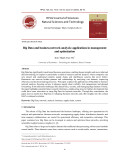
ISSN 1859-1531 - TẠP CHÍ KHOA HỌC VÀ CÔNG NGHỆ - ĐẠI HỌC ĐÀ NẴNG, VOL. 22, NO. 9A, 2024 7
DEVELOPMENT OF AN AUTOMATIC EGG FERTILITY DETECTION SYSTEM
APPLYING IMAGE PROCESSING TECHNIQUE
NGHIÊN CỨU CHẾ TẠO HỆ THỐNG PHÁT HIỆN TRỨNG CÓ PHÔI TỰ ĐỘNG
ỨNG DỤNG XỬ LÝ ẢNH
Vo Nhu Thanh*, Dinh Quynh Nhu, Nguyen Dac Minh Triet, Pham Anh Duc
The University of Danang - University of Science and Technology, Vietnam
*Corresponding author: vnthanh@dut.udn.vn
(Received: June 16, 2024; Revised: August 01, 2024; Accepted: September 09, 2024)
Abstract - Early detection of infertile and non-hatchable eggs
benefits hatcheries by saving space, reducing costs, and
preventing contamination from spoiled eggs. An automated
system has been developed to detect and mark non-hatchable eggs
efficiently. The system includes a conveyor that moves trays of
100 eggs through a high-power LED light assembly. Images of
the illuminated eggs are captured by an industrial camera and
processed using image processing technology. The eggs,
analyzed 25 at a time, are filtered through an HSV filter and
classified based on the blurred area. The classification results are
then used to control stepper motors that mark spoiled eggs. Real-
time experiments demonstrated an average accuracy rate of
approximately 82.55% for eggs aged 4 days or more, with a
processing speed of under 15 seconds per batch of 100 eggs.
Tóm tắt - Việc phát hiện sớm trứng không có phôi và không thể
ấp nở đem lại lợi ích cho các trại ấp bằng cách tiết kiệm không
gian, giảm chi phí và ngăn ngừa sự ô nhiễm từ trứng bị hỏng. Một
hệ thống tự động đã được phát triển để phát hiện và đánh dấu
trứng không thể ấp nở một cách hiệu quả. Hệ thống bao gồm một
băng tải di chuyển khay chứa 100 quả trứng qua một cụm đèn
LED công suất cao. Hình ảnh của các quả trứng được chiếu sáng
được chụp bởi một camera công nghiệp và xử lý bằng công nghệ
xử lý hình ảnh. Các quả trứng, được phân tích 25 quả một lần,
được lọc qua bộ lọc HSV và phân loại dựa trên vùng bị mờ. Kết
quả phân loại sau đó được sử dụng để điều khiển động cơ bước
đánh dấu trứng bị hỏng. Các thí nghiệm thực tế cho thấy độ chính
xác trung bình khoảng 82,55% đối với trứng từ 4 ngày tuổi trở
lên, với tốc độ xử lý dưới 15 giây cho mỗi lô 100 quả trứng.
Key words - Automation; image processing; egg detection; high
power LED system.
Từ khóa - Tự động hóa; xử lý ảnh; phát hiện trứng; đèn LED
công suất cao.
1. Introduction
In a poultry egg incubation model, one crucial step that
cannot be overlooked is the egg sorting process to
determine whether the eggs are capable of hatching chicks
or not. This is an extremely important step because if
unchecked and left in the incubation process, infertile eggs
will decay and give rise to harmful bacteria within the
incubator, thereby affecting the eggs that are still
developing. Additionally, infertile eggs, when sorted early,
can be sold as food, providing additional income for
businesses and family-run enterprises, thus preventing
waste and environmental pollution.
The ability to automatically detect fresh eggs with no
embryo during the incubation process allows timely
removal of non-developing and dead-embryo eggs from
the incubation process, contributing to the overall
profitability of the livestock farm as eggs that cannot be
incubated can be brought to market earlier.
Poultry egg incubation models have been used in
Vietnam for quite some time, but most of these models
involve manual operation with relatively low precision.
Current manual methods include: Method 1. Determining
how many days the egg has been incubated; Method 2. The
transparency of the eggshell was observed; Method 3.
Candling eggs; Method 4. Egg flotation test; Method 5.
The eggs were placed on a listening device [1]. Most small
and medium-sized enterprises in our country still operate
this sorting process manually, using labor for visual
inspection, which can be time-consuming and prone to
errors, especially for large quantities of eggs. The egg
incubators on the Vietnamese market [2] are mainly egg
incubators; however, a crucial step in the poultry egg
incubation model that cannot be ignored is the egg sorting
process to determine whether the eggs can hatch chicks,
and there is currently no automated machine.
Today, some companies worldwide, such as Sanovov [3]
and Viscon [4], have successfully designed and
manufactured automated egg sorting models with hatching
potential, but they can only identify and classify older eggs
(from 12 days old). Techniques such as machine vision and
light spectrum analysis have been developed to address egg-
related issues, including detecting blood spots, reproductive
ability, and embryo development [5]-[7]. Imaging methods
have also been used to detect external defects, such as dirt
and cracks in eggs, although this detection is more
challenging than detecting internal defects. In addition, some
studies have used ultrasound to detect external defects such
as dirt and cracks in eggs [8]-[10]. There are also some
studies on classifying young eggs that have been proposed,
but complete classification systems [11]-[14] have yet to be
developed, mainly offering ideas and specific classification
plans for each type of poultry egg. Recognizing these
difficulties, we propose applying image processing
techniques and automation technology to increase labor
productivity and reduce costs in operations, thereby helping
businesses save human resources, improve production
efficiency, and contribute to business development.
Therefore, developing an automated egg sorting system
with high speed, a compact size suitable for family
business criteria, and the ability to sort poultry eggs

8 Vo Nhu Thanh, Dinh Quynh Nhu, Nguyen Dac Minh Triet, Pham Anh Duc
younger than current proposals is suggested. An image of
a cluster of eggs is automatically examined and captured
using high-intensity LED lights to prepare for the sorting
process. The images are processed with enhanced
brightness and combined with image processing
algorithms to differentiate between eggs capable of
incubation and sterile eggs based on marked traces. The
executive system will sort eggs that can hatch and those
that cannot, based on the marked traces.
2. System configuration
Figure 1 shows a general diagram of the automated
chicken egg scanning system. The main systems of the
machine include a central control system with a computer
used to process images captured from cameras and an
Arduino board to control the LED light system and motors
through specialized driver modules. The system is powered
by 220 V of electricity which is then converted to the
correct voltage and rated power for each device through
switching circuits. This system interacts with users via a
computer screen to communicate processing information
and results after machine operations.
Figure 1. System Configuration
2.1. Mechanical construction
The overall mechanical structure of the chicken egg
sorting system described in Figure 2 includes a dual
conveyor belt system on both sides to move trays
containing 100 chicken eggs. These conveyor belts are
equipped with tensioning mechanisms to ensure belt
tension during operation and are driven by DC motors with
attached gearboxes for speed reduction. Below the
conveyor belts is a high-power LED lighting system used
for candling with 100 LED bulbs mounted in a 10x10
matrix configuration. Above the conveyor belt is a camera
system mounted on a sliding mechanism controlled by a
stepper motor capable of moving back and forth to capture
different areas of the egg tray. At the end of the conveyor
belt is a system consisting of marking pens to mark eggs
identified as non-hatchable. This pen system consists of 10
ink pens controlled for vertical movement by a servo motor
mechanism, with each pen equipped with a spring to reduce
contact force on the eggshell to prevent breakage.
The frame of the machine is made of square section steel
measuring 10×10 mm, with overall dimensions of
3850×1590×1450 mm. The camera and marking pen frames
are made of shaped aluminum to ensure the aesthetic
appearance and structural rigidity of the system. The motors
for the conveyor belt system, cameras, and pens are selected
and calculated to ensure sufficient power and the required
speed. Specifically, the conveyor belts move eggs at a speed
of 0.05 m/s with planetary GX43775 – 12 V reduction gear
motors. The camera drive assembly is powered by two
17HS8401 stepper motors moving on shaped 20x40
aluminum. Ten marking pens are driven by ten MG995 servo
motors at 60 rpm through a rack and pinion mechanism to
ensure fast and stable pen movements up and down.
Figure 2. Machine overview
The Arduino board controls stepper motor for camera
movement via electronic and programming interfaces. It
sends pulse (step) and direction signals to stepper motor
drivers, which convert these signals into the currents that
drive the motors. Pulse signals determine the number of
steps, controlling the motor's speed, while direction signals
control the rotation direction. Micro stepping, configured
by the Arduino, allows for finer control and smoother
motion. Stepper motors require a separate power supply,
managed by the motor driver as shown in Figure 1. The
operational details of the motor drive for the entire system
are described in Section 2.4.
2.2. High Power LED system
To illuminate a system of 100 eggs, we divided the
process into four sessions, each involving the illumination of
25 eggs, equivalent to 5 rows and 5 columns of an egg tray
per session. To calculate the wattage for a cluster of 25
LEDs, each rated at 1 watt and operating at 2 V, but powered
by a 5 V source, we must determine the configuration of the
LEDs and any necessary current-limiting resistors.
Since the LEDs are rated at 2 V and we have a 5 V
power supply, each LED cannot be directly connected
across 5 V. We need to use current-limiting resistors.
Each LED is rated at 1 W and 2 V. The current through
each LED is:
𝐼 = 𝑃
𝑉=1𝑊
2𝑉 = 0.5𝐴 (1)
Each LED requires 0.5 amps (500 mA) of current. The
voltage drop needed across the resistor is 5 V-2 V= 3 V.
To decrease the voltage to 3 V at 0.5 A, the resistor can
be calculated using Ohm's Law:
𝑅 = 𝑉
𝐼=3𝑉
0.5𝐴 = 0.6 𝛺 (2)

ISSN 1859-1531 - TẠP CHÍ KHOA HỌC VÀ CÔNG NGHỆ - ĐẠI HỌC ĐÀ NẴNG, VOL. 22, NO. 9A, 2024 9
The power dissipation in the resistor is:
𝑃 = 𝑉 × 𝐼 = 3𝑉 × 0.5𝐴 = 1.5 𝑊 (3)
The total power consumption includes the power used
by the LEDs and the resistors. For each LED-resistor pair:
Total power per LED-resistor pair = 1 W + 1.5 W = 2.5 W
For 25 LEDs: Power25LED = 25×2.5 W=62.5 W
Calculate the Total Wattage for 4 Clusters of 100 LEDs.
Total Power = 4×62.5 W=250 W (4)
The total power (250 W) and the voltage (5 V) can be
used to calculate the total current:
𝑇𝑜𝑡𝑎𝑙 𝐶𝑢𝑟𝑟𝑒𝑛𝑡 = 𝑇𝑜𝑡𝑎𝑙 𝑃𝑜𝑤𝑒𝑟
𝑉𝑜𝑙𝑡𝑎𝑔𝑒 =250𝑊
5𝑉 =50 𝐴 (5)
The power supply required for a system that includes
4 clusters of 25 LEDs, with each cluster consuming
62.5 W, should be capable of providing 5 V at 50 A.
The measured value is lower than 50 A because we have
not considered the factor of resistance in each LED and
actual measurements show that the resistance in each LED
significantly affects the total current needed. The resistance
value of each LED is not fixed and tends to increase as the
temperature of each LED becomes increases.
Figure 3. Circuit design principles
Figure 4. 3D LED circuit design
In practice, supplying power to a cluster of 25 high-
power LEDs can easily cause the driver circuit to overheat.
Therefore, to reduce the heat generated, we divided the
cluster of 25 LEDs to be powered by two driver circuits, with
one circuit powering 13 LEDs and the other powering 12
LEDs. A schematic diagram, 3D design diagram, and actual
circuit images are shown in Figures 3, 4, and 5, respectively.
Since this system has relatively high power for a
common electronic circuit, we use four relays that can act as
protective devices, automatically disconnecting when
overload or short circuits are detected in the system. An
Arduino Nano controller is used to control the LED lighting
algorithm. Additionally, we use LM2596 an low-voltage
regulator module, a voltage converter module that converts
DC input voltage from 3 to 40 V into output voltage from
1.5 to 35 V, with a maximum output current of 3 A, to
regulate the voltage signal for the LED driver system.
In this system, we manage heat and ensure the longevity
of LEDs by implementing several strategies including
attaching aluminum heat sinks as shown in Figure 4 and 5
and using thermal paste or pads for improved heat transfer,
utilizing active cooling with increased airflow area, using
current-limiting resistors and constant current drivers to
prevent overheating, ensuring an appropriately rated power
supply, designing an efficient PCB layout with thermal vias
and larger copper areas, and employing Pulse Width
Modulation (PWM) dimming to reduce average power
dissipation without compromising light quality.
Figure 5. Actual LED circuit board
2.3. Egg scanning method
Based on the process of embryo development in
chicken eggs as depicted in Figure 6 [15], we observed that
fertilized eggs developed blood vessels after 4 to 8 days of
incubation. If the egg shows dark rings around it, it has
been invaded by bacteria and cannot hatch into a chick. In
some cases, the appearance of porous spots when candling
eggs is also considered damaged, with an 80% chance that
they will not hatch. Figure 7 shows images of actual eggs
captured by the research team for differentiation purposes.
Figure 6. Development process of a chicken egg [15]
As shown in Figure 7, eggs older than 5 days that are
not fertilized will allow light from the LED system to pass
through an unobstructed system and will be marked "Not
OK" as seen in the image. Other types of eggs that can
hatch will allow light to pass through but will be
obstructed, forming dark areas of varying sizes. The larger
the area is the older the egg and the closer it is to hatching;
smaller areas indicate younger eggs that need further
observation to ensure normal development.
Image processing involves capturing images using a camera
module and preprocessing them with noise reduction filters and
brightness/contrast adjustments. The images are converted from

10 Vo Nhu Thanh, Dinh Quynh Nhu, Nguyen Dac Minh Triet, Pham Anh Duc
RGB to HSV color space for effective color-based
segmentation [6]. Thresholding is applied to isolate objects
based on specific Hue, Saturation, and Value (HSV) ranges.
Morphological operations, such as erosion and dilation, are
used to remove noise and fill gaps in the segmented objects.
Contours are detected and extracted for further analysis,
including object recognition and measurement, and features
such as shape, size, and position are extracted.
The HSV color space is chosen for its ability to separate
color (Hue) from intensity (Value), facilitating color-based
segmentation. It is robust to lighting variations, as changes
in brightness and shadows primarily affect the Value
component, leaving Hue and Saturation relatively stable.
This simplifies thresholding and improves segmentation
accuracy, making it more effective for detecting and
tracking specific colors.
Figure 7. Image of the sampled eggs
With the requirement of identifying eggs with the least
amount of dark areas for rejection, the author has
employed the idea of calculating the dark area on the egg
to determine whether it should be rejected. Once the dark
area has been determined, it will be compared to a fixed
threshold; if it is larger than the threshold, the egg will be
rejected, and vice versa.
Figure 8. Egg detection algorithm
To calculate the area, we first need to preprocess the
image by resizing it to 150 ×150 pixels and converting it to
a binary image with only black and white color. By
converting the image to the HSV color space and then
adjusting the three parameters H (Hue), S (Saturation), and
V (Value), we obtain the desired image.
After applying the HSV color filter, the dark areas on
the egg appear white, and the light areas be black. At this
point, we draw contours around the white regions on the
egg to calculate the enclosed area. We then compared the
calculated area to the minimum area (2000) that a fertilized
egg could have, to determine whether the egg had been
fertilized. Figure 8 shows the algorithm flowchart for this
image processing procedure.
2.4. Main algorithm and user interface
Figure 9 shows the overall algorithm flowchart of the egg
candling machine for detecting hatching chicken eggs. First,
when the system is activated, all the modes are set up. When
an egg tray is loaded, the conveyor motor moves the tray of
100 eggs to the correct position, as detected by sensor 1. Next,
the conveyor motor stops, and the egg tray is positioned above
the LED lighting system. The camera motor then sequentially
moves to 4 positions corresponding to 4 egg candling zones
(each zone containing 25 positions as mentioned in section
2.3). After each movement and capture, the faulty eggs are
recorded and displayed on the interface (Figure 10). Finally,
the egg tray is moved to the marking pen position, where the
pens will move up and down to mark the faulty eggs that
cannot hatch based on the detected positions.
Figure 9. Main algorithm
Figure 10. Machine interface
The system interface consists of the following
functional buttons:
CAMERA: Connect the camera to display in interface
ARDUINO: Connect the microcontroller to the computer.
START: The system is started after the camera and
microcontroller are successfully connected to the PC.
STOP: Emergency stop the system.
RESET: Restart system.
CHECK IMAGE: Open the folder containing all image
files displaying the image processing progress.
3. Results and discussion
The team successfully built the machine as shown in
Figure 11. The system was tested during the manufacturing
process. The object under study here is 4 to 12 day-old chicken
eggs, and Table 1 describes the results of 10 machine
operations, with the eggs being classified on June 27, 2023.
Initially, the evaluation team found that the system runs
stably with minimal vibrations during operation. The
system is capable of classifying one tray of eggs
(consisting of 100 eggs) in approximately 15 seconds,

ISSN 1859-1531 - TẠP CHÍ KHOA HỌC VÀ CÔNG NGHỆ - ĐẠI HỌC ĐÀ NẴNG, VOL. 22, NO. 9A, 2024 11
significantly reducing labor time and increasing
productivity and economic efficiency for the business. The
accuracy is calculated as 100% minus the absolute value of
the difference between the actual and eliminated eggs (by
the machine) divided by the actual number of eggs (percent
error). The actual value represents the number of eggs
identified as unhatchable by expert worker.
According to Table 1, the machine's accuracy is not
stable; however, the average accuracy rate is within the
desired range of 80%. This discrepancy is primarily due to
variations in the color of the eggs. For eggs with dark
brown shells or excessively thick shells, there is a higher
rate of misclassification. Errors can also arise from the size
and positional errors of the eggs, where overly large or
small eggs can obstruct the visibility of smaller eggs
behind them, causing positional deviations in image
processing. Additionally, the lighting environment affects
the accuracy of the images captured by the camera, leading
to variations in the detection system's accuracy. Therefore,
it is necessary to improve the accuracy of classification
software for industrial egg sorting according to the specific
types and sizes of eggs in future versions.
Figure 11. Real Machine
Table 1. Statistics of the system accuracy rates
Test #
Total
Chosen
Actual
Eliminated
Accuracy
1
100
88
15
12
80.00%
2
100
86
15
14
93.33%
3
100
90
10
10
100.00%
4
100
90
13
10
76.92%
5
100
88
12
12
100.00%
6
100
82
16
18
87.50%
7
100
85
12
15
75.00%
8
100
97
5
3
60.00%
9
100
93
9
7
77.78%
10
100
80
16
20
75.00%
Average accuracy
82.55%
4. Conclusion
The developed egg candling and sorting system
demonstrates robust mechanical engineering, ensuring rigidity,
durability, and aesthetic appeal, as proven by three months of
continuous operation without malfunction. Its compact design
facilitates easy transport without compromising component
integrity, outperforming similar products [3], [4].
The software efficiently processes and consolidates data
on classified eggs, exporting this information to an Excel
file. This enables businesses to monitor classification
accuracy and discard rates, allowing for strategic
improvements. The software interface also allows operators
to track the positions of discarded eggs and the total number
of categorized eggs in real-time. As shown in the test in
Table 1, the highest accuracy reached 100% while the lowest
accuracy reached 60%. The lowest accuracy occurred when
using eggs with many size and color differences.
The electrical system is designed by using
commercially available modules and circuits. Thus, the
system reduces processing costs and simplifies installation
and maintenance, enhancing operational uptime. Overall,
the effective performance of the egg candling and sorting
system, provides significant benefits to poultry businesses.
Acknowledgment: This work was supported by The
University of Danang - University of Science and
Technology, Code number of Project T2023-02-03MSF.
REFERENCES
[1] May ap trung CNE, “5 ways to recognize chicken eggs that are about to
hatch and eggs that are being incubated are damaged”, mayapcne.com,
[Online]. Available: https://mayapcne.com/5-cach-nhan-biet-trung-ga-
sap-no-va-trung-ga-ap-bi-hu/ [Accessed June 2024].
[2] P. Nghia, “Egg sorting machine”, nghiaphat.vn, [Online]. Available:
https://phatnghia.vn/san-pham/may-phan-loai-trung/ [Accessed June 2024].
[3] Sanovo Technology Group, “Industry-leading technology for the
handling and processing of table eggs”, sanovoegg.com, [Online].
Available: https://www.sanovoegg.com, [Accessed June 2024].
[4] Viscon Group, “Integrated hatchery solutions”, viscongroup.eu,
[Online]. Available: https://viscongroup.eu/expertise/hatchery-
automation, [Accessed June 2024].
[5] D. P. Smith, J. M. Mauldin, K. C. Lawrence, B. Park, and G. W.
Heitschmidt, “Detection of fertility and early development of
hatching eggs with hyperspectral imaging”, in Proceedings 11th
European Symposium on the Quality of Eggs and Egg Products,
Doorwerth, The Netherlands, 2005, pp. 176-182.
[6] R. T. Elster and J. W. Goodrum, “Detection of cracks in eggs using
machine vision”, Transactions American Society of Agricultural
Engineering, vol. 34, pp. 307-312, 1991. doi: 10.13031/2013.31663
[7] Y. J. Han and Y. Feng, “Egg shell inspection using global image
analysis”, Applied Engineering in Agriculture, Vol. 10, pp. 109-114,
1994. doi: 10.13031/2013.25835
[8] H. K. Cho, W. K. Choi, and J. H. Pack, “Detection of surface cracks
in shell eggs by acoustic impulse method”, Transactions American
Society of Agricultural Engineers, Vol. 43, pp. 1921-1926, 2000.doi:
10.13031/2013.3097
[9] B. D. Ketelaere, F. Bamelis, B. Kemps, E. Decuypere and J. D.
Baerdemaeker, “Non-destructive measurements of the egg quality”,
World’s Poultry Science, Vol. 60, pp. 289-302, 2004.
https://doi.org/10.1079/WPS200417
[10] B. D. Ketelaere, P. Coucke and J. D. Baerdemaeker, “Eggshell crack
detection based on acoustic resonance frequency analysis”, Journal
of Agricultural and Engineering Research, Vol. 76, pp. 157-163,
2000. https://doi.org/10.1006/jaer.2000.0542
[11] L. Liu, and M. Ngadi, “Detecting fertility and early embryo
development of chicken eggs using near-infrared hyperspectral
imaging”, Food and Bioprocess Technology, Vol. 6, pp. 2503–2513,
2013. https://doi.org/10.1007/s11947-012-0933-3
[12] M. Ghaderi, S.A. Mireei, A. Masoumi, et al, “Fertility detection of
unincubated chicken eggs by hyperspectral transmission imaging in
the Vis-SWNIR region”, Sci Rep Vol. 14, 1289, 2024.
https://doi.org/10.1038/s41598-024-51874-2
[13] L. Liu, M.O. Ngadi, “Detecting Fertility and Early Embryo
Development of Chicken Eggs Using Near-Infrared Hyperspectral
Imaging”, Food Bioprocess Technol, Vol. 6, pp. 2503–2513, 2013.
https://doi.org/10.1007/s11947-012-0933-3
[14] K. C. Lawrence, D. P. Smith, W. R. Windham, G. W. Heitschmidt and B.
Park, “Egg embryo development detection with hyperspectral imaging”,
International Journal of Poultry Science, Vol 5, no. 10, pp. 964-969, 2006.
[15] Life Incubator, “Instructions on how to identify whether a chicken
egg has an embryo or not”, lin.com.vn, [Online]. Available:
https://www./huong-dan-cach-nhan-biet-trung-ga-co-trong-hay-
khong [Accessed June 2024].


























